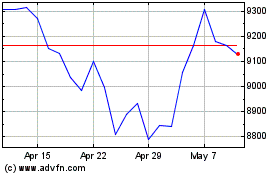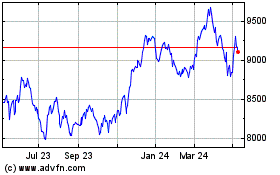European central bankers this week began testing how a bank
default would pressure certain trade-plumbing firms, the latest
sign of concern over the clearinghouses that aim to limit markets'
vulnerability to the damaging fire sales that characterized the
2008 crisis.
Stress-testing clearinghouses, alongside a related discussion of
the terms of any public assistance they may receive in a pinch, are
issues at the top of the agenda for many regulators, bankers and
investors, following the adoption of postcrisis rules that placed
these safety nets at the center of financial-system overhauls.
Which conditions might merit public financial assistance is an
issue that the Federal Reserve hasn't taken a public position
on.
The Bank of England along with Germany's Bundesbank and Federal
Financial Supervisory Authority, or BaFin, on Tuesday started to
simulate a hypothetical default by a bank at both the SwapClear
unit of London Stock Exchange Group PLC's LCH.Clearnet Group Ltd.
and Deutsche Bö rse AG's Eurex Clearing, said people familiar with
the test.
The effort comes as investor nervousness about the health of big
banks is on fresh display, with shares of large banks down
significantly this year on both sides of the Atlantic, amid slowing
global growth and falling interest rates. Barclays PLC's
London-listed shares were down 21% this year at midday Thursday,
and Deutsche Bank AG's Frankfurt-listed shares were down 33%.
The exercise is the first example of concurrent stress tests at
two clearinghouses, the people familiar with the event said, and
the first of its kind to be initiated by central banks. Existing
rules dictate the companies must run their own routine stress tests
on an individual basis at least once a year.
Clearinghouses such as LCH and Eurex are supposed to help
prevent a marketwide collapse by ensuring trading partners get paid
even if one defaults. In a 2009 regulatory pact, leaders of the
Group of 20 nations agreed to process hundreds of trillions of
dollars of derivatives through clearinghouses.
Now, analysts are concerned the expanded use of clearinghouses
could magnify the effects of the next crisis. Central bankers have
moved to fortify clearinghouses, taking lessons from bank stress
tests, without committing explicit financial support in advance to
avoid creating a "moral hazard" that analysts warn could cause
excessive risk-taking by clearinghouses. When a clearinghouse runs
into trouble, a primary line of defense is capital from its member
banks.
In the U.S., the question of when the Fed would assist an ailing
clearinghouse is murky and politically charged following the 2008
taxpayer bailout of American International Group Inc.
Wall Street would like clearinghouses to have liquidity from the
U.S. central bank so long as the firms remain solvent, according to
Thomas Kloet, a former chief executive of exchange operator TMX
Group Ltd. and chairman of a subcommittee within the market risk
advisory group at the Commodity Futures Trading Commission.
Emily Portney, a clearing executive with J.P. Morgan Chase &
Co., said at a CFTC committee meeting last year that the reason
banks and other participants are aligned on the issue is because
without dedicated central-bank support "you're actively allocating
liquidity out to banks at the worst possible time."
Last year, the European Central Bank and the Bank of England
announced new measures to enhance the liquidity and stability of
clearinghouses, but said they were extending facilities called
existing swap lines to the firms "without pre-committing to the
provision of liquidity."
In the U.S., the Fed hasn't publicly stated how and when it
would provide liquidity to clearinghouses in stressed periods. The
central bank has authority under the 2010 Dodd-Frank
financial-overhaul law to offer clearinghouses borrowing privileges
"only in unusual or exigent circumstances" so long as certain
requirements are met and firms have tried to borrow privately.
Still, there remains a concern that such assistance could be
viewed as tantamount to a government backstop.
In a November speech, Fed governor Jerome Powell said, "By
design, increased central clearing will concentrate risks in
[clearinghouses]; it is essential that, as these risks accumulate,
[they] build up their ability to manage them."
Last year, regulators at the Fed and the Securities and Exchange
Commission started pushing a large U.S. repo clearinghouse to shore
up its finances with a new $50 billion credit facility provided by
its member banks or other institutions, but met resistance from
smaller industry participants who complained they would have to
leave the market.
Next Wednesday, policy makers and central bankers, including Fed
Vice Chairman Stanley Fischer, will gather in Washington for a
conference about last-resort lending organized by the Committee on
Capital Markets Regulation.
Hal Scott, Nomura professor of international financial systems
at Harvard Law School, said when comparing all last-resort lending
powers across Europe, the U.K., Japan and the U.S., the Fed has
"the weakest of the four," in part because of new restrictions
placed in the postcrisis Dodd-Frank law.
Any expansion of the Fed's lending authority to clearinghouses
"could have much harsher implications for the next financial crisis
than anything they have done in the banking or the securities
industries," said Norbert Michel, a research fellow in financial
regulation at the Heritage Foundation, a conservative think
tank.
AIG had fully repaid the bailout by the end of 2012 and the
government made a $22.7 billion profit. But last year, a court
ruled the government exceeded its authority in completing the 2008
rescue.
At the CFTC hearing last November, Kevin McClear, an executive
at clearinghouse and exchange operator Intercontinental Exchange
Inc., said, "We think the best source to get Treasury liquidity
would be the Fed. We don't want to borrow money, but we think we
should have access to the discount window…only during times of
stress, not as business as usual."
Write to Katy Burne at katy.burne@wsj.com
(END) Dow Jones Newswires
February 04, 2016 16:35 ET (21:35 GMT)
Copyright (c) 2016 Dow Jones & Company, Inc.
London Stock Exchange (LSE:LSEG)
Historical Stock Chart
From Mar 2024 to Apr 2024

London Stock Exchange (LSE:LSEG)
Historical Stock Chart
From Apr 2023 to Apr 2024
